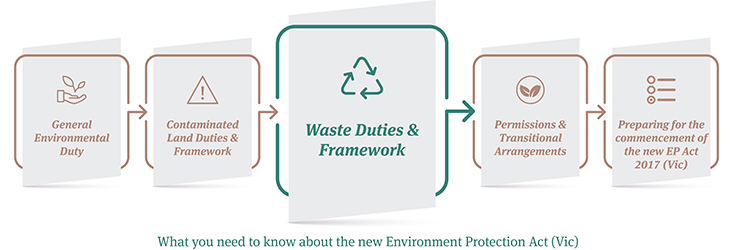
The Environment Protection Act 2017 (Vic) incorporating amendments from the Environment Protection Amendment Act 2018 (Vic) (New Act) will reshape the way wastes and waste generating activities are regulated in Victoria.
In our previous legal update we provided an overview of the new terminology, new duties, new penalties, new permissions, and the levy scheme which will apply to waste under the new regime.
Since then, the Environment Protection Regulations 2021 (New Regulations) have been gazetted so there is now greater certainty regarding how the obligations will need to be met.
What are the new waste duties?
In summary, the New Act and New Regulations create various duties to regulate the full waste supply chain, including:
- General Environmental Duty – minimise risks of harm to human health and the environment (from pollution or waste) so far as reasonably practicable when undertaking activities
- Duties of persons depositing industrial waste – send industrial waste to a place authorised to receive it
- Duties of persons receiving industrial waste – receive industrial waste only if the place is authorised to receive it
- Duties of persons transporting industrial waste – take reasonable steps to ensure waste is transported and received at a place authorised to receive it (including identifying and classifying the waste, providing sufficient information to the next person in the supply chain, verifying the place is authorised to receive the waste)
- Duties of persons managing priority waste – ensure the waste is classified, contained, isolated, provide information to the next person in the supply chain to help them meet their duties
- Duties to investigate alternatives to waste disposal – take all reasonable steps to identify and assess alternatives to waste disposal for priority waste
- Duties to notify of transaction for reportable priority waste – inform the EPA each time a reportable priority waste changes hands using the EPA’s electronic waste tracker
- Duties of persons transporting reportable priority waste – ensure reportable priority waste is not transported or caused or allowed to be transported other than in accordance with a permission.
Apart from the duties, what are the significant changes to how industrial wastes are regulated?
- Many materials will continue to remain an industrial waste until they are reused for an original purpose given matter will still be defined to be a waste after it is discarded or if it is surplus, irrespective of any potential use or value.
- Many materials not currently subject to specific regulatory control will be captured by the new regime applying to waste generators and waste receivers.
- Many materials may require a Declaration of Use1 (DoU) to enable them to be reused (this will apply to most industrial but not reportable priority wastes, except when a permission is required or the material requires further processing or storage).
- The EPA will issue determinations2 (Determinations) for common industrial wastes (such as fill material, composts, manures, animal wastewaters and aggregates). If the conditions of the determination are met, a DoU won’t be required.
- Numerous existing waste and resource recovery facilities will be subject to new licence, permit or registration regulation.
How will the regulation of waste soils change?
A significant change will be the introduction of new categories for waste soils including asbestos in soils and a new Category D, as well as new oversight of fill material by the EPA.
Fill material
Fill material (often called “clean fill”) will be regulated by the New Regulations.
It will be considered an industrial waste (but not a priority waste).
As such, you may need to:
- Reusing it onsite in accordance with a Determination for fill material or
- Disposing of it offsite in accordance with a relevant permit, registration, licence or reusing it offsite in accordance with a Determination. Importantly, a DoU cannot be used to apply fill material to land.
Soil containing asbestos only
To manage soil containing asbestos only (SCAO) you may need to:
- Undertake sampling to ensure it is SCAO (i.e. ensure its contaminant concentrations are not greater than the upper limit for fill material). Where visible asbestos-containing material is removed in accordance with occupational health and safety legislation, it will not be SCAO (it could be fill material provided the other contaminant concentrations meet the fill material criteria)
- Ensure it is sent to a place authorised to receive it – either retain it in a structure designed to contain it onsite3 or send it to a landfill authorised to accept soil with asbestos4
- Ensure it is tracked and transported in accordance with a transport permission
Category D
Category D will be a new priority waste category which applies only to soil.
To meet the duties related to reportable priority waste – Category D you may need to:
- Undertake testing to ensure that the contaminants are greater than the upper limits for fill material but below the upper limits for Category D set out in the Waste Disposal Publication
- Ensure it goes to a place authorised to receive it given it is a reportable priority waste – by:
- Retaining it in a structure designed to contain it onsite5 or contain on a project site where the waste soil was generated6
- Treating it to ensure its contaminants meet fill material criteria
- Sending it to a landfill or other site authorised to receive it
- Ensuring it is tracked and transported in accordance with a transport permission
How can you prepare for the introduction of the new waste duties and management of waste soil?
Before the waste duties and new requirements for management of waste soil under the New Act commence, you can prepare by:
- Familiarising yourself with the new duties, their requirements and guidance – there are numerous sources of information about the new waste framework apart from the New Act and New Regulations. These currently include summary of the waste framework, EPA guidance on establishing lawful place, classifying industrial waste and waste code transition. There is also intended to be a landfill compliance code.7 Make sure you are familiar with the material the EPA is continuing to publish and review this material to assist you to understand and comply with the new waste duties.
- Considering whether your organisation generates or receives industrial waste – if so, consider which of the duties relating to industrial waste apply and consider what systems you have in place to ensure compliance with the duties. Check the Determinations to make sure the waste (particularly fill material) complies with the parameters set out in the Determination.
- Considering whether your organisation generates, transports or receives priority waste – if so, consider whether you have appropriate systems in place to classify the waste and ensure that the waste can be contained and isolated. If you need to transport the priority waste, ensure that you understand the requirements of the Waste Tracker system and that you have undertaken due diligence on your waste transporters to ensure they hold the requisite permits. Consider the requirement to investigate alternatives to waste disposal and ensure that your evaluation, including review of publicly available information and consultation with any relevant organisations, is appropriately documented.
- Considering whether you require an additional permission – do you need to get a DoU, are you transporting reportable priority waste? Are you retaining contaminated soil on site? Are you involved in a recycling or resource recovery activity which isn’t currently regulated, but will be under the New Act?
- Considering whether you will be sending industrial waste to an authorised place – if so, have you altered your contracts to ensure responsibility for compliance with the duties is covered, have you got measures in place to ensure you know what the waste is and that the place receiving the waste is authorised to receive it?
Do you have a question, need some advice or a training workshop? Please contact a member of our team.










